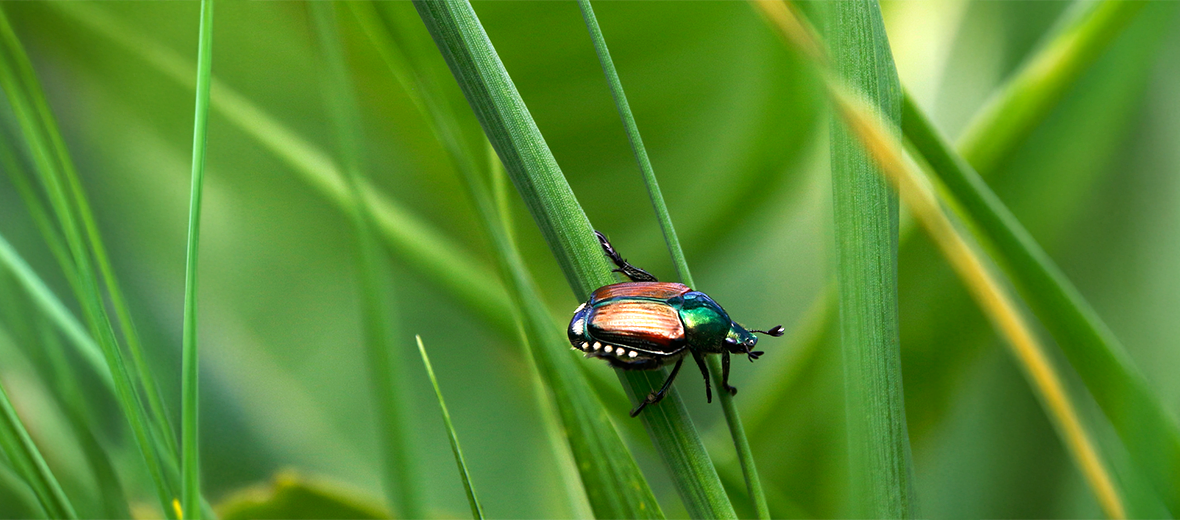
While the Japanese beetle is not classified as a pest species in its native Japan, in Europe and North America they are a pest to over 300 species of plant life. Plants such as birch trees, cannabis, crape myrtles, grapes, hops, linden trees, rose bushes, and more are all affected by these beetles. Japanese beetles are not evaluated by the IUCN due to their vast population and propensity for being an invasive pest species.
First the Stats…
Scientific name: Popillia japonica
Length: Up to .60 inch
Lifespan: Up to 1 year as a grub | Up to 45 days as an adult
Now on to the Facts!
1.) Damage caused by Japanese beetles is caused by skeletonizing the plant’s foliage (consuming the fleshy part of the leaf between its veins). They will also often go after fruits too. Grubs consume roots of plants which can lead to disease and death of the host plant.
2.) These beetles were first described by English entomologist Edward Newman in 1841.
3.) Grubs measure up to 1 inch in length.
4.) Males are slightly smaller than females.
5.) Native to Japan, these beetles are considered an invasive species in Europe and North America.
But wait, there’s more on the Japanese beetle!
6.) The first appearance of these critters in the United States was in a nursery near Riverton, New Jersey in 1916.
7.) They apparently entered the U.S. via a shipment of iris bulbs just prior to 1912.
Did you know…?
Most of this beetle’s life is spent as a larva, with only up to 45 days spent as an imago (the last stage an insect attains during its metamorphosis).
8.) As of 2015, only 9 western states of the United States were deemed free of Japanese beetles.
9.) Only 3 were detected in Washington State in 2020, however, from late June – September 2021, there were over 20,000 found in Grandview, Washington alone.
10.) Eggs are laid individually or in small groups near the surface of the soil.
But wait, there’s still more on the Japanese beetle!
11.) Females lay up to 60 ova (eggs) in her short life.
12.) The ova hatch in up to 2 weeks and at that time the larvae begin feeding on grass and other plant roots as well as organic matter in the soil.
Did you know…?
In Japan, these beetles have a total lifespan of up to 2 years; most of which is spent as a grub.
13.) As the larvae mature, they develop into a c-shaped grub that feast on progressively thicker roots and can do economic damage to various pastures and turfs.
14.) Larvae hibernate in small cells within the soil, emerging in the spring when the soil temperatures increase again. Within up to 6 weeks of leaving hibernation, the larvae will pupate into adults.
15.) Traps baited with floral scent, pheromone, or both are often utilized to trap these pests. however, a study found that these traps tend to backfire more often than not in that the beetles will often not enter the trap, but rather stop along the way and damage neighboring foliage even more. This is due to the scents attracting even more beetles to the area.
But wait, there’s even more on the Japanese beetle!
16.) During their larval stage they are susceptible to a fatal disease called milky spore disease, caused by a bacterium by the same name, aka Paenibacillus (previously Bacillus) popilliae. The USDA created this biological control, and it is commercially available in powder form for application to lawn areas.
17.) However, the previously mentioned biological control can take up to 4 years to fully soak into the soil and become effective at killing the grubs.
Did you know…?
Recently studies have begun to explore a microsporidian pathogen, Ovavesicula popilliae, as a type of biocontrol against Japanese beetles. This pathogen causes swelling, inefficiency in the gut, and can eventually cause microsporidiosis in the infected beetles.
18.) On field crops like squash, floating row covers can be used to keep the beetles away, but this can result in the need for hand pollination of the flowers, since the row covers also keep bees out.
19.) Biocontrol has also been utilized, in the form of parasitoid flies and wasps. This has had some success.
20.) Japanese beetles are diurnal (active during the day).
Now a Short Japanese Beetle Video!
Be sure to share & comment below! Also, check out the Critter Science YouTube channel. Videos added regularly!
Want to suggest a critter for me to write about? Let me know here.
Some source material acquired from: Wikipedia & IUCN




